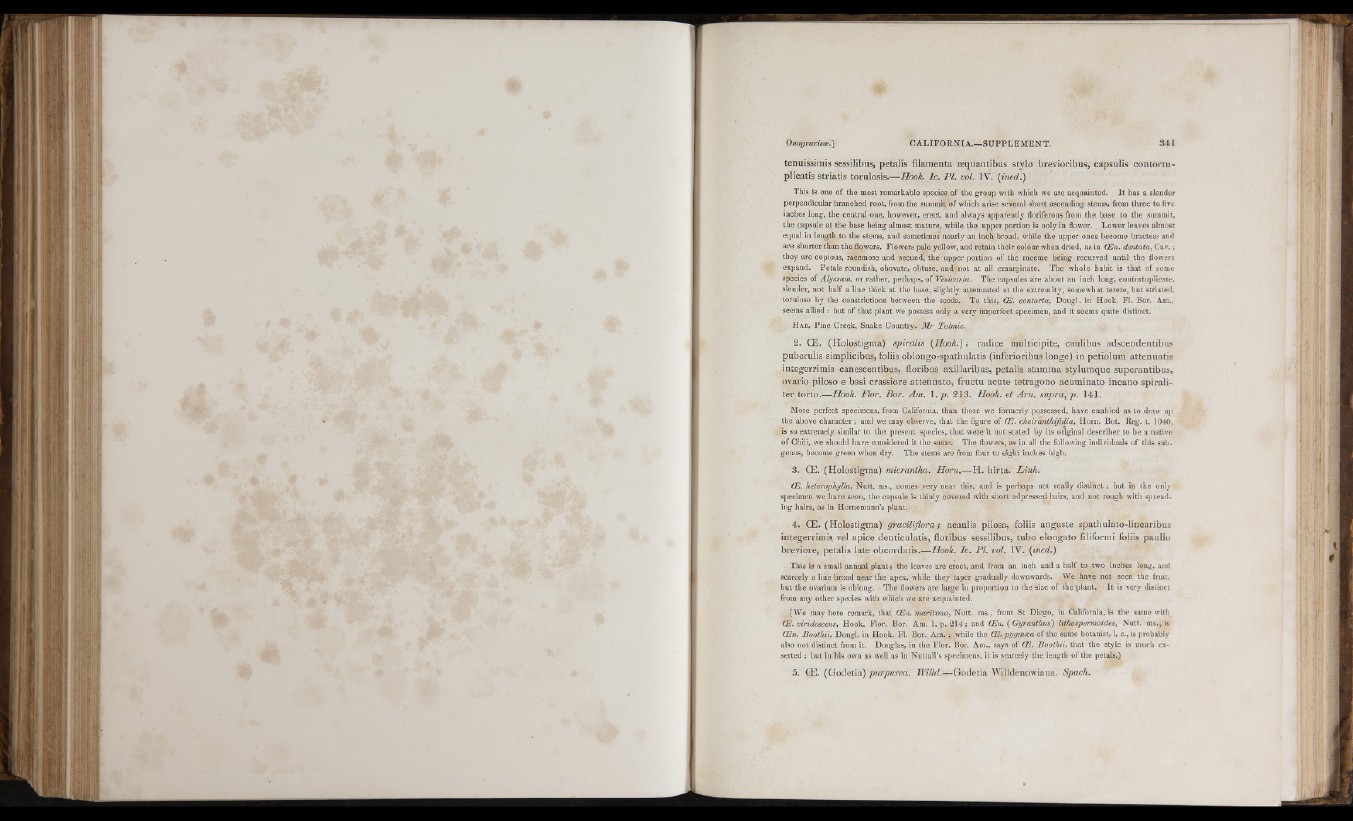
'i'
-p. 4
' i!
tenuissimis sessilibus, petalis filamenta æquantibus stylo brevioribus, capsulis contortu«
plicatis striatis torulosis.— Hook. Ic. P L vol. IV. {ined.)
This is one of the most remarkable species of the group with which we are acquainted. It has a slender
perpendicular branched root, from the summit of which arise several short ascending stems, from three to five
inches long, the central one, however, erect, and always apparently floriferous from the base to the summit,
the capsule at the base being almost mature, while the upper portion is only in flower. Lower leaves almost
equal in length to the stems, aud sometimes nearly an inch broad, while the upper ones become bracteæ and
are shorter than the flowers. Flowers pale yellow, and retain their colour when dried, as in OEn. dentata, Cav. ;
they are copious, racemose and secund, the upper portion of the raceme being recurved until the flowers
expand. Petals roundish, obovate, obtuse, and not at all emarginate. The whole habit is that of some
species of Ahjssum, or rather, perhaps, of Vesicaria. The capsules are about an inch long, eontortuplicate.
slender, not half a line thick at the base, slightly attenuated at the extremity, somewhat terete, but striated,
torulose by the constrictions between the seeds. To this, OE. contorta, Dougl. in Hook. Fl. Bor. Am.,
seems allied ; but of that plant we possess only a very imperfect specimen, and it seems quite distinct.
H ab. Pine Creek, Snake Country. Mr Tolmie.
2. OE . (Holostigma) spiralis {Hook.) ; radice malticipite, caulibus adscendentibus
puberulis simplicibus, foliis oblongo-spathulatis (inferioribus longe) in petiolum a tten u a tis
integerrimis canescentibus, floribus axillaribus, petalis stamina stylumque superantibus,
ovario piloso e basi crassiore a tten u ate, fructu acute tetragono acuminato incano spiraliter
torto,—Hook. Flor. Bor. Am. l . p . 213. Hook, et Arn. supra, p . 141.
More perfect specimens, from California, than those wc formerly possessed, have enabled us to draw up
the above character; and we may observe, that the figure of CE. cheiranthifolia, Horn. Bot. Reg. t. 1040,
is so extremely similar to the present species, that were it not stated by its original describer to be a native
of Chili, we should have considered it the same. The flowers, as in all the following individuals of this sub-
genus, become green when dry. The stems are from four to eight inches high.
3. CE. (Holostigma) micrantha. Horn.— H . h irta. L in k .
CE. heterophylla, Nutt, ms., comes very near this, and is perhaps not really distinct; but in the only
specimen we have seen, the capsule is thinly covered with short adpressed hairs, and not rough with spread-
ing hairs, as in Hornemann’s plant.
4. CE. (Holostigma) gracilifiora-, acaulis pilosa, foliis anguste spathulato-Iinearibus
integerrimis vel apice denticulatis, floribus sessilibus, tubo elongato filiformi foliis paullo
breviore, petalis late obcordatis.—Hook. Ic. PI. vol. IV. {ined.)
This is a small annual plant; the leaves are erect, and from an inch and a half to two inches long, and
scarcely a line broad near the apex, while they taper gradually downwards. We have not seen the fruit,
but the ovarium is oblong. The fiowers are large in proportion to the size of the plant. It is very distinct
from any other species with which we arc acquainted.
(We may here remark, that CEn. maritima, Nutt, ms., front St Diego, in California, is the same with
CE. viridescens, Hook. Flor. Bor. Am. l .p . 214; and CEn. {Gyranthus) lithospei'moides, Nutt, ms., is
CEn. Boothii, Dougl. in Hook. Fl. Bor. Am. ; while the CE. pygmaa of the same botanist, 1, c., is probably
also not distinct from it. Douglas, in the Flor. Bor. Am., says of CE. Boothii, that the style is much exserted
; but in his own as well as in NuttalTs specimens, it is scarcely the length of the petals.)
5. CE. (Godetia) Willd.—Godetia Willdenowiana. Spach.